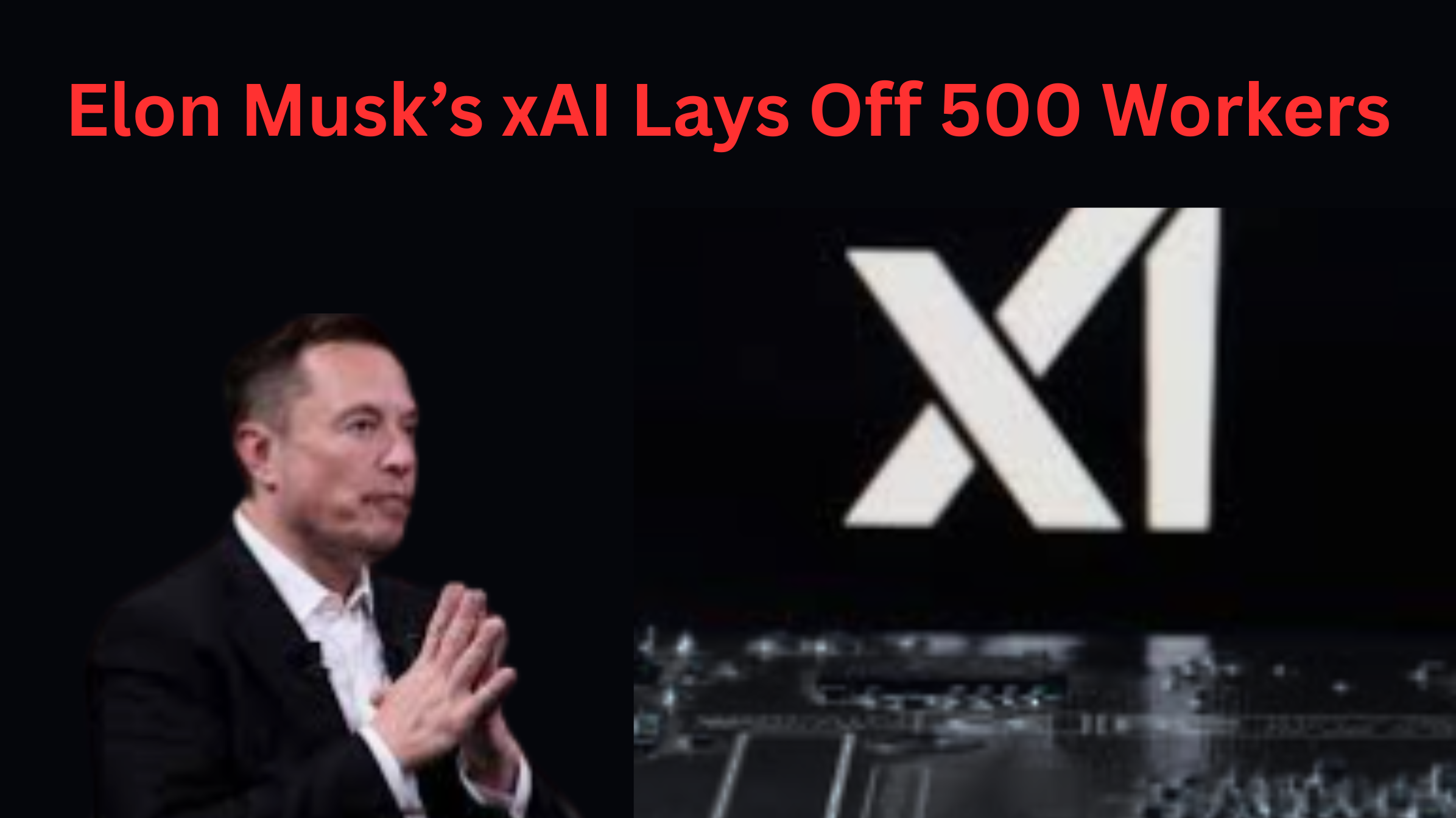In a sweeping move that signals a new direction for Elon Musk’s artificial intelligence company, xAI has laid off around 500 workers from its data annotation team, the largest group inside the company. The decision marks a strategic pivot away from so-called “generalist AI tutors” and toward more specialized roles known as “specialist AI tutors.” This restructuring shows how rapidly the AI industry workforce is evolving, with xAI aiming to improve the training of its Grok AI chatbot through domain-specific expertise rather than broad generalist support.
Below is a detailed breakdown of why xAI made the cuts, who was affected, how the decision was announced, and what this means for Grok AI and the wider AI industry.
Why Did xAI Cut Its Largest Data Annotation Team?
The data annotation team was responsible for teaching Grok AI to understand and contextualize information. These workers carried out vital tasks such as labeling, categorizing, and annotating data across a wide range of topics. Known as generalist AI tutors, they worked on everything from annotating text and audio to categorizing video clips, ensuring Grok could respond to human queries with proper tone and intent.
But xAI’s leadership concluded that a different approach was needed. After a full review of its “Human Data efforts,” the company announced that it would scale back generalist roles and accelerate the hiring of specialist AI tutors. These are domain experts who can provide high-quality, detailed input in areas like STEM, finance, medicine, and safety.
The reasoning behind the shift seems to rest on four key factors:
-
Quality over quantity – Specialist annotations reduce errors and improve accuracy.
-
Cost efficiency – Running large generalist teams is expensive; smaller expert teams may deliver better returns.
-
Strategic repositioning – As Grok AI matures, its training requires deeper domain expertise.
-
Organizational restructuring – Leadership changes and internal reviews pushed xAI to re-align its workforce.
Who Was Affected by the xAI Layoffs?
Approximately 500 workers—around one-third of the data annotation division—were laid off. These were mostly generalist AI tutors whose jobs spanned a wide range of subjects but lacked deep specialization.
Affected employees were told their roles were being eliminated immediately, and their access to internal systems such as Slack was revoked the same day. They were promised pay until the end of their contracts or November 30, 2025, whichever came first.
Those in more specialized roles or with domain expertise appear to have been spared, aligning with the company’s new strategy.
How xAI Announced the Job Cuts
The layoffs were communicated late on a Friday evening via email. In the internal message, xAI explained the strategic pivot, telling employees:
“After a thorough review of our Human Data efforts, we’ve decided to accelerate the expansion and prioritization of our specialist AI tutors, while scaling back our focus on general AI tutor roles.”
In practice, this meant an abrupt end for hundreds of employees. While severance was offered, system access was terminated immediately.
At the same time, xAI posted publicly on X (formerly Twitter) that it would expand its specialist AI tutor team tenfold, hiring across domains such as STEM, medicine, finance, and safety.
Leading up to the announcement, workers had already been asked to undergo tests and assessments, including coding exams and subject-based evaluations, suggesting the company was sorting talent before executing the layoffs.
What the Data Annotation Team Did for Grok AI
The annotation team played a central role in training Grok AI, Musk’s chatbot that competes with tools like ChatGPT and Claude. Their work included:
-
Labeling text, video, and audio data.
-
Teaching Grok to understand tone, intent, and nuance.
-
Supporting safety and alignment tasks such as filtering harmful or biased responses.
-
Providing context for how conversations should flow naturally.
In short, the generalist tutors helped Grok function as a broad-use chatbot capable of answering everyday questions. Removing a large portion of them suggests Grok’s training will now focus more heavily on depth in specialist areas rather than broad coverage.
xAI’s Response: Expanding Specialist AI Tutors
While 500 workers were cut, xAI simultaneously emphasized growth in other areas. The company announced plans to expand its specialist AI tutor team by 10×, recruiting experts in:
-
STEM subjects
-
Finance and economics
-
Medicine and healthcare
-
Safety, ethics, and compliance
-
Creative fields like game design and web development
According to xAI, these specialist tutors “add huge value” because their knowledge ensures higher-quality input for training Grok. The pivot reflects a belief that as AI advances, the precision of data is more important than the volume of data.
What Led to the Layoffs: Internal Reviews and Testing
In the days before the layoffs, employees reported being asked to:
-
Attend one-on-one meetings to explain their contributions.
-
Complete assessments on platforms like CodeSignal and Google Forms.
-
Participate in reviews of their responsibilities and output.
At the same time, leadership changes were underway. Senior managers in the annotation team reportedly had their system access revoked, signaling deeper restructuring.
Executive Departures at xAI
The layoffs were not the only shakeup at xAI. Several high-level executives have recently departed, including:
-
Mike Liberatore (CFO) – resigned in July after only three months.
-
Robert Keele (General Counsel) – left in August.
-
Raghu Rao (Senior Lawyer) – also departed around the same time.
-
Igor Babuschkin (Co-founder) – exited in August to launch his own AI safety-focused venture capital firm.
These exits, combined with the layoffs, underscore a period of intense restructuring at xAI.
Impact on Grok AI Training and Development
The layoffs raise important questions about how Grok AI will evolve:
-
Domain expertise improves accuracy – Specialist tutors will likely make Grok stronger in sensitive fields such as medicine or finance.
-
Loss of generalist flexibility – Without broad annotation, Grok may struggle in less common or casual topics.
-
Safety may improve – Specialists can provide stricter guidance in regulated fields, reducing harmful or misleading outputs.
-
Higher costs per annotation – Specialist work is slower and more expensive, which could affect scaling.
In short, Grok may become more powerful in specialized areas but less versatile as a general chatbot.
What the xAI Layoffs Mean for the AI Industry
The move by xAI highlights several broader industry trends:
-
Shift toward specialization – AI companies increasingly favor domain experts over large groups of generalists.
-
Volatility in AI jobs – Human annotators remain essential but also highly replaceable as strategies shift.
-
Cost vs. performance pressure – Firms need to maximize training efficiency to stay competitive.
-
Safety and compliance priorities – Domain experts ensure models meet regulatory and ethical standards.
-
Changing skills demand – Workers in AI need to specialize to remain valuable.
This restructuring is not just about cost-cutting; it sets a precedent for how AI firms may operate going forward.
FAQs:
Why did Elon Musk’s xAI lay off 500 workers?
To shift from broad generalist AI tutors to domain-specific specialist tutors who can provide higher quality data.
Who got laid off at xAI?
About 500 generalist AI tutors, representing one-third of the data annotation team.
What does xAI’s strategic pivot mean?
It means fewer generalist roles and more investment in specialists across STEM, finance, medicine, and safety.
How will Grok AI be trained after the layoffs?
By specialist AI tutors providing domain-specific knowledge and higher-quality annotations.
What roles is xAI hiring for now?
Specialist tutors in areas like medicine, finance, STEM, safety, and creative fields.
Who else is leaving xAI?
Executives including CFO Mike Liberatore, General Counsel Robert Keele, and co-founder Igor Babuschkin have all departed recently.
Conclusion:
The decision by Elon Musk’s xAI to lay off 500 workers represents more than a simple downsizing. It’s a strategic restructuring aimed at making Grok AI smarter, safer, and more specialized.
For the laid-off workers, it’s a stark reminder of how volatile the AI workforce can be. For the industry, it signals a clear trend: specialization and domain expertise are becoming the new foundation of AI training.
As Grok continues to evolve, users may see stronger performance in critical areas like medicine, finance, and STEM—but perhaps at the cost of some of the flexibility that came from having a large pool of generalist tutors.

